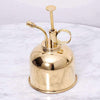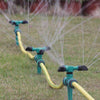
Watering your plants with tea
of reading
If you're reading this article, it's probably because the idea of pouring the last of your cup of tea into your plants has crossed your mind. Don't worry, you're not crazy; many passionate gardeners do it!
This fun way to recycle the remains of a cooled or poorly measured tea has many benefits for our plants. Tea has been known for centuries for its healing and soothing qualities. The history of tea is as rich and complex as its flavors, and we found it interesting to repurpose its use in the garden.
Its properties, durability, and ease of use make it a natural and easy-to-test fertilizer. The properties of tea are very similar to those of fertilizers and can help reduce costs for those who are already heavy tea drinkers.
Enough talk, let's get down to business together now!
Is tea good for plants?
When we prepare a cup of our favorite tea, we rarely think about the variety of ingredients contained in the tea bags. This aromatic beverage contains thousands of them, some of which are still being discovered and researched.
First of all, tea leaves are naturally occurring organic matter. Most of these organic materials are excellent plant nutrients . Dried tea leaves contain approximately 4.4% nitrogen, 0.24% phosphorus, and 0.25% potassium. There is much more nitrogen in tea leaves than in most liquid fertilizers for potted plants. However, the latter are much higher in phosphorus.
The large amount of nitrogen, however, should be tempered. We are not certain of the exact amount that the roots are able to absorb.
Here are some of the healthy elements found in tea:
- Polyphenols : Micronutrients found in plant-based foods. A strong cup can contain up to 240 mg of polyphenols.
- Tannic acid : a very present element, affecting the acidity of the soil.
- Theanine: An amino acid commonly found in tea leaves and bolete mushrooms. Not to be confused with theine, which is caffeine.
- Antioxidants : They provide powerful protection against cell damage. Natural antioxidants can include phenols, lignans, tannins, and flavonoids.
- Vitamins and Minerals : Green and black teas are rich in vitamins C, D, and K, as well as riboflavin. Minerals present include calcium, iron, magnesium, nickel, zinc, and fluoride.
What type of tea should I use?
Rest assured, you shouldn't have to adapt your tea break to your plant's tastes. This practice primarily serves to recycle your forgotten cups. Your plant will have to get used to it, but it won't be the one choosing between an Earl Grey or an English Breakfast . However, we recommend that you choose organic tea brands to avoid pesticide traces.
As a guide, here are the pH values of different tea varieties:
- Black Tea : pH 5 to 5.5
- Green Tea : pH 7 to 10
- Herbal tea : pH 6 to 7
Can it be used if it has been mixed with sugar or milk?
In reasonable quantities, these ingredients will provide slow-release nutrients. Small bacteria will then appear temporarily, giving the plant time to absorb them. Read our article on the benefits of milk for watering now.

Obviously, avoid any brand of sweetened iced tea soda, such as Iced Tea . These drinks are way too sweet and usually contain all sorts of preservatives.
How to water your plants with tea?
There are three different methods for watering tea. These depend on how you consume tea. The good news is that all three methods are simple and cost-effective. They give gardeners an excuse to enjoy an extra cup of their favorite brew. You'll never feel guilty about letting your mug go cold again!
The rest of the teapot method:
If you don't want to consume the rest of your teapot, don't feel guilty; your plants will benefit from it. Just wait for the water to cool completely. You should definitely not pour boiling water over your plant. This would completely burn its root system and prevent it from feeding. Avoid hot water, and even lukewarm water in general. In nature, plants never come into contact with hot water. Their bodies are trained to withstand frost and extreme cold. However, neither their branches nor their roots are designed to withstand hot water.
The used bag method:
Another method is to bury a used tea bag in the ground . Just make sure the tea bag is made of paper and can decompose easily. We don't recommend using polyester tea bags. If you forget, it would be a shame to leave plastic in your pot.
The tea bag's staple and string should also be removed. They add nothing at all and are not particularly aesthetically pleasing.
The watering can method:
This third method is an invention of our team, inspired by the previous two. It allows you to reuse your tea bags without leaving them lying around in your flower pot. Our method consists of letting your used tea bag infuse in your watering can.
However, the infusion time will be longer, as the water will be cold. We recommend leaving your bag overnight until the next watering cycle.
P.S.: Please note that if you have just watered your houseplant, there is no need to overwater it by adding your leftover tea. This practice should be incorporated into your watering habits, but should not be added.

Is this tip recommended for all plants?
The powerful nutrients in tea will benefit some plants, but not all. Remember the acidic nature of tea leaves. Amino acids and tannic acids enrich the soil by lowering its pH (thereby increasing the acidity of the soil).
We recommend this practice for plants that like it. Rest assured, pouring tea on plants with more alkaline (less acidic) soil will not harm them. However, you will see less progress than for plants with acidic soil .
Here is a selection of plants that appreciate the acidity of the soil:
- Rubber plant
- Spider plant
- Oxalis
- Philodendron
- Begonias (some varieties)
- African violets
- Orchids (some varieties)
- Easter lily
- Poinsettia
- Tomatoes
- Hydrangeas
- Ferns
When it comes to ferns, most thrive in slightly acidic soil. The only exception is the Maidenhair Fern, which needs more alkaline soil .
Finish your cup and take action!
Ultimately, tea can be a unique way to complement certain plants in your home and garden. Its main advantages are its natural composition, ease of use, and cost savings. We see gardening as a fun and relaxing way to unwind, so this practice seems like a perfect fit!
However, we do not recommend preparing tea specifically for watering and we prefer to use old tea that has not been drunk.








S adrapeau
Toute l’année, je ramasse le thé après son infusion pour le Kumbucha, le laisse sécher et l’utilise au printemps pour les hydrangésn (Hortensia). C’est du thé de Chine bio…. Ça vaut la peine de lui trouver un second usage.
Tardy
Merci pour toutes ces informations bien utiles
Par contre j’aurais souhaité savoir si le thé déjà utilisé, une fois séché était nourrissant également pour les plantes?
Merci dans l’attente de votre réponse
Cdt
Me Tardy
Laurence
Bjr
Merci pour ces conseils très judicieux.
Je voulais savoir. J’ai du thé noit que je n’aime pas. Il est en vrac.
Au lieu de le jeter, pourrais-je l’utiliser autour de mes plantes sans le faire infuser ??et si oui, quelle quantité mettre ?
Je vous souhaite une belle journée
Claudette
Bonjour M. Fleurant. Moi, depuis 21 ans, j’arrose mon arbre ficus et à tous les 2 à 3 ans, je dois le couper car il pousse c’est incroyable. Je ne l’ai jamais mis dans un autre plat. J’adore ça pour mes plantes. Je l’arrose aux 2 à 3 semaines. Je me demandais pourquoi qu’il poussait autant et qu’il a tellement l’air en santé . je viens de lire vos explications. Merci beaucoup et bonne soirée. 2023 06 22 19h56
Lis@
Merci pour tous vos conseils, j’adore …